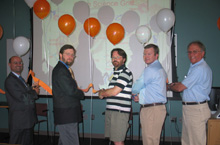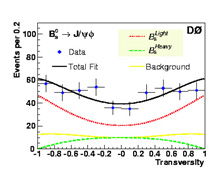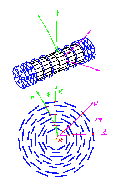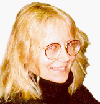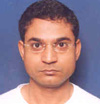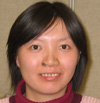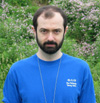 | Thursday, July 21, 2005 |
|
Thursday, July 21 2:30 p.m. Theoretical Physics Seminar - Curia II Speaker: Z. Nagy, Zürich University Title: Matching Parton Showers to NLO Computations 3:30 p.m. DIRECTOR'S COFFEE BREAK - 2nd Flr X-Over THERE WILL BE NO ACCELERATOR PHYSICS AND TECHNOLOGY SEMINAR TODAY
Friday, July 22 |
|
Extended Forecast |
Secon Level 3 |
|
Thursday, July 21 Santa Fe Black Bean Soup Sloppy Joe $4.85 Stuffed Peppers $3.75 Sauteed Liver & Onions $3.75 Baked Ham & Swiss on a Ciabatta Roll $4.85 California Pizza $3.00 Crispy Fried Chicken Ranch Salad $4.85 The Wilson Hall Cafe now accepts Visa, Master Card, Discover and American Express at Cash Register #1.
Wilson Hall Cafe Menu |
| Fermilab Today is online at: http://www.fnal.gov/today/ Send comments and suggestions to today@fnal.gov Fermilab Today archive Fermilab Today PDF Version Fermilab Result of the Week archive Fermilab Safety Tip of the Week archive Linear Collider News archive Fermilab Today classifieds Subscribe/Unsubscribe to |
|
Now Open for Scientific Research: Open Science Grid | ||
| ||
|
Milwaukee, WI — The Open Science Grid Consortium today (Wednesday, July 20) officially inaugurated the Open Science Grid, a national grid computing infrastructure for large scale science. The OSG is built and operated by teams from U.S. universities and national laboratories, and is open to small and large research groups nationwide from many different scientific disciplines.
The Consortium currently has over 20 member organizations contributing manpower and resources to a common cyberinfrastructure. Research groups that join the Consortium contribute to the use and operation of the OSG and have access to shared resources. The OSG includes over 10,000 CPUs and access to many terabytes of data storage. Initial funding comes from a variety of sources through member organizations.
U.S. participants in experiments at the Large Hadron Collider, currently being built at CERN in Geneva, Switzerland, invest heavily in advancing OSG capabilities and development schedule. Other projects in physics, astrophysics, gravitational-wave science and biology contribute to the grid and benefit from advances in grid technologies. The services provided by the OSG will be further enriched as new projects and scientific communities join the Consortium.
|
|
From the GDE Director's Corner, July 20 | ||
| ||
|
....Superconducting RF has emerged over the past several decades as a key
technology for particle accelerators. Last week, many of the leaders of
that field participated in the "12th International Workshop on RF
Superconductivity," held at Cornell University from July 10-15.
This year's workshop was very capably organized by Hasan Padamsee
(chair of the organizing committee) and his colleagues. The meeting covered
many of the latest advances in the science, technology and applications of
RF superconductivity to particle accelerators. It included reviews of the
status of a large range of applications currently underway, as well as many
ideas and proposals for applications. Not surprisingly, at this year's meeting,
there was much emphasis on the linear collider. There were talks on new
developments of various types that could improve the performance of ILC cavities,
there was a special session with industry, and the final "ILC fest" featured talks
by Maury Tigner, Gerry Dugan and me.
|
|
July 18 - July 20 - During this 48 hour period Operations established two stores that combined with an existing store provided the experiments with approximately 27 hours and 46 minutes of luminosity - MI suffers from RF and damper problems - RF trip causes TeV store abort
Read the Current Accelerator Update |
|
From PhysicsWeb, July 20, 2005 New Light on the Weak Force An international collaboration of particle physicists has made new measurements that shed more light on the weak force, which is responsible for radioactive beta-decay. The results, which agree with the Standard Model, show that the strength of the weak force acting on two electrons lessens when the electrons are far apart (hep-ex/0504049). "Physicists have long expected that the weak-force interactions would be weaker at longer distances, but proving it wasn't easy," says experiment co-spokesman Krishna Kumar, who is at the University of Massachusetts-Amherst.
In the E158 experiment at the Stanford Linear Accelerator Center (SLAC), a high-energy beam of electrons is fired at a liquid hydrogen target. The beam is polarized with the spins of the electrons either pointing in the same direction as the beam (so-called right-handed polarization) or in the opposite direction (left-handed polarization). The vast majority of electrons scatter off electrons in the target by exchanging a photon, but very occasionally an electron does so by exchanging a Z boson instead.
|
|
The Heavy Twin Appears to Live Longer? | ||||
|
Currently the Tevatron is the only place where Bs mesons (containing
an anti-b-quark and a strange quark) can be produced. These mesons are
particularly interesting since they are made up of a quantum
mechanical entanglement of two physical particles: a "heavy" mass
state and a slightly less massive "light" state. In addition to a
tiny mass difference between them (also being explored at Fermilab),
it is expected that they have slightly different lifetimes.
The two states have identical decay products, but a careful analysis
of the angular distribution of their decays to J/psi and phi particles
allow their separation and a measurement of each of their lifetimes.
A large enough lifetime difference may allow explorations of possible Previously the DZero Collaboration measured a single effective lifetime of the Bs meson via this decay (see 28 Oct. 2004 Result of the Week). DZero has now extended this work to find that the B_s meson is produced in the "heavy" mass state roughly 16% of the time. This state then subsequently lives slightly longer than the "light" mass state (in contrast to the usual situation of "heavier" brothers having shorter lifetimes!). Details and results of this analysis have been submitted to Physical Review Letters. | ||||
| ||||
| ||||
|
Result of the Week Archive | ||||
|
|
|
Drug Sniffing Dogs Perform at Fermilab On Friday, July 22, the CDF band Drug Sniffing Dogs will be playing in the Users' Center at 7:30 p.m. These "rendition rockers" have about 35 songs spanning the last 40 years of rock 'n' roll ready for Friday. Vocalist Ben Kilminster recommends that audience members "bring your dancing shoes and your new tattoos," and says the band will play particle physics-themed interpretations of certain songs by request.
New Classifieds on Fermilab Today
Third Thursday Lunchtime Cleanup on July 21 |
